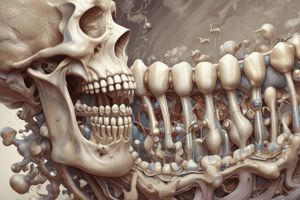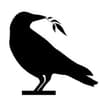Podcast
Questions and Answers
What role does inorganic pyrophosphate (PPi) play in bone mineralization?
What role does inorganic pyrophosphate (PPi) play in bone mineralization?
- Inhibits hydroxyapatite formation (correct)
- Enhances osteocalcin activity
- Promotes calcification
- Increases calcium absorption
Which of the following substances is primarily responsible for regulating blood calcium and phosphate levels systematically?
Which of the following substances is primarily responsible for regulating blood calcium and phosphate levels systematically?
- Inorganic pyrophosphate
- Osteopontin
- Vitamin D (correct)
- Osteocalcin
Which osteoblast-derived protein is responsible for promoting mineralization?
Which osteoblast-derived protein is responsible for promoting mineralization?
- Osteocalcin (correct)
- FGF23
- Inorganic pyrophosphate
- Osteopontin
Where is inorganic pyrophosphate (PPi) predominantly found?
Where is inorganic pyrophosphate (PPi) predominantly found?
What is the effect of active Vitamin D on inorganic pyrophosphate secretion levels?
What is the effect of active Vitamin D on inorganic pyrophosphate secretion levels?
What is the role of parathyroid hormone (PTH) in bone resorption?
What is the role of parathyroid hormone (PTH) in bone resorption?
Which hormone serves as a direct inhibitor of osteoclastic bone resorption?
Which hormone serves as a direct inhibitor of osteoclastic bone resorption?
Which of the following hormones is NOT a regulator of osteoblastic bone formation?
Which of the following hormones is NOT a regulator of osteoblastic bone formation?
During what phase of the bone remodeling cycle does new bone formation occur?
During what phase of the bone remodeling cycle does new bone formation occur?
Which statement accurately describes the effect of oestrogen on bone remodeling?
Which statement accurately describes the effect of oestrogen on bone remodeling?
What is the primary function of osteocytes in bone tissue?
What is the primary function of osteocytes in bone tissue?
Which type of cell is known for resorbing bone?
Which type of cell is known for resorbing bone?
Osteoprogenitor cells can differentiate into which of the following cell types?
Osteoprogenitor cells can differentiate into which of the following cell types?
Where are osteoprogenitor cells primarily located?
Where are osteoprogenitor cells primarily located?
Which statement about osteogenic cells is correct?
Which statement about osteogenic cells is correct?
What determines the fate of osteoprogenitor cells?
What determines the fate of osteoprogenitor cells?
Which type of cells primarily produce bone matrix?
Which type of cells primarily produce bone matrix?
Which of the following is NOT a fate of osteoprogenitor cells?
Which of the following is NOT a fate of osteoprogenitor cells?
What is the primary function of osteoclasts?
What is the primary function of osteoclasts?
What process do osteoclasts use to digest the organic matrix of bone?
What process do osteoclasts use to digest the organic matrix of bone?
Which substance is known to inhibit the activity of osteoclasts?
Which substance is known to inhibit the activity of osteoclasts?
What structure do osteoclasts form to significantly increase their surface area for absorption?
What structure do osteoclasts form to significantly increase their surface area for absorption?
What is the role of tartrate-resistant acid phosphate (TRAP) in osteoclast activity?
What is the role of tartrate-resistant acid phosphate (TRAP) in osteoclast activity?
What happens to osteoclast progenitor cells upon activation by RANK ligand?
What happens to osteoclast progenitor cells upon activation by RANK ligand?
Which of the following describes Howship’s lacunae?
Which of the following describes Howship’s lacunae?
What is the significance of the sealing zones formed by osteoclasts?
What is the significance of the sealing zones formed by osteoclasts?
What characterizes the diaphysis of a bone?
What characterizes the diaphysis of a bone?
Why does the thickness of cortical bone increase further from the joint?
Why does the thickness of cortical bone increase further from the joint?
What function does the diaphysis serve in relation to muscle movement?
What function does the diaphysis serve in relation to muscle movement?
What mechanical principle allows for increased force at the fulcrum when using the diaphysis as a lever?
What mechanical principle allows for increased force at the fulcrum when using the diaphysis as a lever?
What type of bone predominates at the epiphysis of a long bone?
What type of bone predominates at the epiphysis of a long bone?
Which statement best explains the variation in bone structure across different parts?
Which statement best explains the variation in bone structure across different parts?
How do the mechanical properties of the bone affect its function?
How do the mechanical properties of the bone affect its function?
What physical analogy is used to describe the function of the diaphysis?
What physical analogy is used to describe the function of the diaphysis?
What is the main characteristic of cancellous bone compared to cortical bone?
What is the main characteristic of cancellous bone compared to cortical bone?
What is Wolff's Law primarily concerned with?
What is Wolff's Law primarily concerned with?
How does mechanotransduction occur in bones under load?
How does mechanotransduction occur in bones under load?
What happens to cancellous bone when the load is removed?
What happens to cancellous bone when the load is removed?
What is the approximate diameter of the struts in cancellous bone?
What is the approximate diameter of the struts in cancellous bone?
Which of the following best explains the high turnover rate of cancellous bone?
Which of the following best explains the high turnover rate of cancellous bone?
How do osteocytes participate in the remodeling of bone?
How do osteocytes participate in the remodeling of bone?
Which professional is most likely to exhibit increased bone density in specific areas?
Which professional is most likely to exhibit increased bone density in specific areas?
Flashcards
Osteocytes
Osteocytes
Maintain bone tissue.
Osteoblasts
Osteoblasts
Produce bone matrix.
Osteoclasts
Osteoclasts
Resorb bone (remove existing bone).
Osteoprogenitor cells
Osteoprogenitor cells
Precursor cells differentiating into other bone cells.
Signup and view all the flashcards
Mesenchymal stem cells
Mesenchymal stem cells
The origin of osteoprogenitor cells.
Signup and view all the flashcards
Multiple possible fates
Multiple possible fates
Osteoprogenitor cells can become various cell types.
Signup and view all the flashcards
Bone marrow and periosteum
Bone marrow and periosteum
Locations of osteoprogenitor cells.
Signup and view all the flashcards
Bone repair and growth
Bone repair and growth
Functions of osteoprogenitor cells.
Signup and view all the flashcards
Osteoclast Function
Osteoclast Function
Bone reabsorption by dissolving hydroxyapatite and organic matrix through proteolytic digestion.
Signup and view all the flashcards
Osteoclast Activation
Osteoclast Activation
RANK-Ligand activates osteoclast progenitor cells to fuse and become multinucleated osteoclasts.
Signup and view all the flashcards
Ruffled Border
Ruffled Border
The highly folded surface of osteoclasts, maximizing surface area for bone resorption.
Signup and view all the flashcards
Howship's Lacunae
Howship's Lacunae
Small pits formed by osteoclasts as they resorb bone.
Signup and view all the flashcards
Calcitonin's Effect
Calcitonin's Effect
Inhibits osteoclast activity.
Signup and view all the flashcards
TRAP Enzyme
TRAP Enzyme
Tartrate-resistant acid phosphatase, used by osteoclasts to dissolve hydroxyapatite.
Signup and view all the flashcards
Sealing Zones
Sealing Zones
Osteoclasts anchor to bone surface for bone resorption.
Signup and view all the flashcards
Bone Resorption Products
Bone Resorption Products
Osteoclasts release inorganic & organic products to extracellular fluid via the secretory domain.
Signup and view all the flashcards
Inorganic pyrophosphate (PPi)
Inorganic pyrophosphate (PPi)
A local regulator that inhibits bone mineralization by blocking calcification and hydroxyapatite formation.
Signup and view all the flashcards
Systemic regulation of bone mineralisation
Systemic regulation of bone mineralisation
Bone mineralisation is regulated by endocrine factors like PTH, Vitamin D, and FGF23, in contrast to local factors like PPi.
Signup and view all the flashcards
Osteoblast-derived proteins
Osteoblast-derived proteins
Proteins like osteocalcin and osteopontin that influence bone mineralisation by either promoting or inhibiting the process.
Signup and view all the flashcards
Local bone mineralization regulation
Local bone mineralization regulation
Mineralization is locally controlled by chemicals like inorganic pyrophosphate (PPi) which blocks the buildup of calcium phosphate crystals.
Signup and view all the flashcards
Role of PPi in bone tissue
Role of PPi in bone tissue
Inorganic pyrophosphate (PPi) acts as a potent inhibitor of bone mineralisation by suppressing calcification and hydroxyapatite formation.
Signup and view all the flashcards
Hormonal Regulators of Osteoclastic Bone Resorption
Hormonal Regulators of Osteoclastic Bone Resorption
Parathyroid Hormone (PTH) increases, while Calcitonin and Estrogen decrease osteoclastic bone resorption.
Signup and view all the flashcards
Hormonal Regulators of Osteoblastic Bone Formation
Hormonal Regulators of Osteoblastic Bone Formation
PTH, Vitamin D, Estrogen, and Growth Hormone increase osteoblastic bone formation.
Signup and view all the flashcards
Bone Remodelling Cycle Stages
Bone Remodelling Cycle Stages
The sequence of steps in bone remodelling: Quiescence, Resorption, Reversal, and Formation.
Signup and view all the flashcards
PTH's Role in RANKL
PTH's Role in RANKL
Parathyroid Hormone (PTH) increases osteoclastic activity by stimulating RANKL release from osteoblasts.
Signup and view all the flashcards
Calcitonin's and Estrogen's Effect on Resorption
Calcitonin's and Estrogen's Effect on Resorption
Calcitonin directly and Estrogen, by reducing RANKL, decrease bone resorption.
Signup and view all the flashcards
Diaphysis Structure
Diaphysis Structure
The mid-section of a long bone, primarily composed of cortical bone.
Signup and view all the flashcards
Epiphysis Structure
Epiphysis Structure
The end of a long bone, primarily composed of cancellous bone.
Signup and view all the flashcards
Cortical bone
Cortical bone
Dense bone tissue, contributing to strength and rigidity.
Signup and view all the flashcards
Cancellous bone
Cancellous bone
Spongy bone tissue, providing strength with less weight.
Signup and view all the flashcards
Bone as Lever
Bone as Lever
Long bones act as levers, increasing muscle force at joints.
Signup and view all the flashcards
Mechanical Requirements (Bone)
Mechanical Requirements (Bone)
Different parts of a bone have different strength/force needs, affecting their structure.
Signup and view all the flashcards
Bone Strength Variation
Bone Strength Variation
Bone composition (cortical/cancellous) varies along the bone to handle different stress forces.
Signup and view all the flashcards
Bone as a Lever (How)
Bone as a Lever (How)
Bone leverage amplifies muscle force at the joint to move limbs more efficiently.
Signup and view all the flashcards
Cancellous Bone Structure
Cancellous Bone Structure
Organized as a loose network of struts, making it less rigid and more elastic than cortical bone.
Signup and view all the flashcards
Cancellous Bone Turnover
Cancellous Bone Turnover
High, allowing for quick remodeling in response to stress.
Signup and view all the flashcards
Wolff's Law
Wolff's Law
Bone adapts to the load placed upon it; bones become stronger in response to stress.
Signup and view all the flashcards
Mechanotransduction in Bone
Mechanotransduction in Bone
Bone responds to mechanical loading by stimulating the remodeling process via fluid movement and sensing.
Signup and view all the flashcards
Bone Remodeling
Bone Remodeling
A continuous process of bone resorption and formation to adapt to environmental demands or stress.
Signup and view all the flashcards
Fluid Movement in Bone
Fluid Movement in Bone
Load-induced fluid movement within bone matrix, triggering osteocyte response and remodeling.
Signup and view all the flashcards
Osteocyte Function Sensing
Osteocyte Function Sensing
Osteocytes sense fluid movement in response to load, stimulating remodeling.
Signup and view all the flashcards
Inorganic Pyrophosphate (PPi) Role
Inorganic Pyrophosphate (PPi) Role
Inhibiting calcification and hydroxyapatite formation, thus regulating bone mineralization.
Signup and view all the flashcardsStudy Notes
Bone Cells
- Bone is formed by four main cell types
- Osteocytes maintain bone tissue
- Osteoblasts form bone matrix
- Osteoclasts resorb bone
- Osteoprogenitor cells are precursor cells that differentiate into different cell lines based on the environment
Osteoprogenitor Cells
- Also known as osteogenic cells
- Mesenchymal stem cells
- Can differentiate into various different cell lines
- Found in bone marrow, endosteum, and periosteum
- Fate determined by environment: minimal movement leads to osteoblast formation; more movement leads to chondrocyte formation
Osteoblasts
- Originate from osteoprogenitor cells
- Single nucleus cells
- Found in periosteum and endosteum
- Produce bone matrix (non-mineralised)
- Synthesise collagen type 1, alkaline phosphatase
- Mineralise the matrix by laying down calcium phosphate
- Produce bone proteins like osteocalcin, osteonectin
Osteocytes
- Former osteoblasts entombed in matrix
- Maintain bone tissue
- Regulate calcium and phosphorus levels in bone
- Communicate with neighbouring cells through canaliculi
- Detect mechanical stress via fluid movement and relay signals via cellular processes
Osteoclasts
- Multinucleated giant cells
- Monocyte/macrophage lineage
- Resorb bone by dissolving inorganic and organic matrix
- Have receptors for calcitonin, which inhibits their activity
- Activated by RANK-Ligand
- Attach to bone surface and become active osteoclasts
Calcium Homeostasis
- Calcium is crucial for crucial for structural, muscle, nerve, and protein functions.
- Normal levels are 2.2-2.6 mmol/L in plasma
- Stored in bone tissue (hydroxyapatite)
Bone Remodeling
- Cycle of bone removal and replacement
- Important for maintaining bone structure and density
- Involved in healing macro-damaged bone
- Also responds to changing loads, reinforcing where load is greatest (Wolff's law)
- Key stages: Quiescence, Resorption, Reversal, Formation (and mineralisation, seen as a separate step in some models)
- Quiescence: resting state, osteoblasts line bone surface, osteocytes sense mechanical stress
- Resorption: osteoclasts dissolve bone matrix
- Reversal: osteoprogenitor cells migrate to resorption pit, differentiate into osteoblasts
- Formation: osteoblasts lay down new bone (osteoid), which mineralises
- Mineralisation: calcium and phosphate deposit to form hydroxyapatite crystals
Summary of different bone types
- Cortical bone: dense, high rigidity, slow turnover rate, major component of bone shaft, organised into osteons and lamellae
- Cancellous bone: a trabecular network in the epiphyses (ends of long bones), lightweight, more elastic, high turnover rate, supports areas of high stress, arranged along lines of maximum mechanical stress
MSK Disease
- MSK disease is a broad term, affecting musculoskeletal (bone, muscle and joint) systems
- MSK diseases affect different age groups, with certain conditions more prevalent in specific age groups
- Includes: perinatal conditions (spinal scoliosis, congenital deficiencies like hemimelia, hand deformities), growth disorders (achondroplasia), trauma/injury, endocrine disorders and nutritional factors such as rickets, and degenerative diseases (osteoporosis, osteoarthritis, rheumatoid arthritis)
- Significant financial burden (NHS costs, productivity loss, etc)
Studying That Suits You
Use AI to generate personalized quizzes and flashcards to suit your learning preferences.





